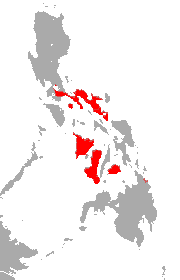| Philippine pygmy roundleaf bat | |
|---|---|
| Scientific classification | |
| Kingdom: | Animalia |
| Phylum: | Chordata |
| Class: | Mammalia |
| Order: | Chiroptera |
| Family: | Hipposideridae |
| Genus: | Macronycteris |
| Species: | H. pygmaeus |
| Binomial name | |
| Hipposideros pygmaeus (Waterhouse, 1843) | |
 | |
| Philippine pygmy roundleaf bat range | |
| Synonyms | |
| |
The Philippine pygmy roundleaf bat (Hipposideros pygmaeus), also called the Philippine pygmy leaf-nosed bat, is a species of bat in the family Hipposideridae. It is endemic to the Philippines, where it has been recorded on Bohol, Luzon (Camarines Sur and Rizal provinces), Marinduque, Negros, Panay, and Mindanao (in Surigao del Sur).
